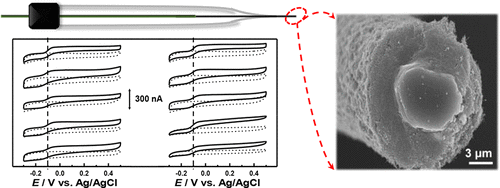当前位置:
X-MOL 学术
›
Anal. Chem.
›
论文详情
Our official English website, www.x-mol.net, welcomes your
feedback! (Note: you will need to create a separate account there.)
Controllable and Reproducible Sheath of Carbon Fibers with Single-Walled Carbon Nanotubes through Electrophoretic Deposition for In Vivo Electrochemical Measurements
Analytical Chemistry ( IF 6.7 ) Pub Date : 2018-03-08 00:00:00 , DOI: 10.1021/acs.analchem.8b00303 Tongfang Xiao 1, 2 , Yanan Jiang 1, 2 , Wenliang Ji 1 , Lanqun Mao 1, 2
Analytical Chemistry ( IF 6.7 ) Pub Date : 2018-03-08 00:00:00 , DOI: 10.1021/acs.analchem.8b00303 Tongfang Xiao 1, 2 , Yanan Jiang 1, 2 , Wenliang Ji 1 , Lanqun Mao 1, 2
Affiliation

|
The unique electronic and chemical structures of carbon nanotubes (CNTs) have well enabled their applications in electrochemistry and electroanalytical chemistry; however, the difficulty in reproducibly confining CNTs onto substrate electrodes, particularly onto microelectrodes, still remains to be addressed. In this study, we develop a method to reproducibly confine single-walled carbon nanotubes (SWNTs) onto carbon fiber microelectrodes (CFEs) with electrophoretic deposition (EPD) for in vivo measurement of ascorbate. Under 2.5 V, acid-treated SWNTs are uniformly deposited on CFEs. After thermal treatment at 300 °C followed by electrochemical treatment in 0.5 M H2SO4, the SWNT-sheathed CFEs exhibit good activity to accelerate the electrochemical oxidation of ascorbic acid (i.e., ascorbate, in a neutral solution) at an onset potential of −0.15 V vs Ag/AgCl and could in vivo selectively detect ascorbate. The controllable procedures employed for EPD and pretreatment avoid the deviation in the conventional manual modification methods such as drop casting and hand rolling previously used for confining SWNTs onto an electrode surface. With the electrodes prepared here, we find that level of extracellular ascorbate in the rat cortex increases by 20.4 ± 4.8% (n = 4), relative to its basal level, within 9 min after infusion of kainic acid into the hippocampus to evoke epilepsy. This study offers a reproducible method to prepare SWNT-sheathed CFEs for in vivo monitoring ascorbate that would largely facilitate future studies on neurochemical processes of ascorbate in various physiological and pathological events.
中文翻译:

单壁碳纳米管通过电泳沉积可控制和可复制的鞘内碳纤维的体内电化学测量。
碳纳米管(CNTs)独特的电子和化学结构使它们在电化学和电分析化学中得到了广泛应用。然而,仍然难以解决将CNT可重复地限制在基板电极上,特别是在微电极上的困难。在这项研究中,我们开发了一种方法,可通过电泳沉积(EPD)将单壁碳纳米管(SWNTs)可复制地限制在碳纤维微电极(CFE)上,用于体内抗坏血酸的测量。在2.5 V下,酸处理的单壁碳纳米管均匀地沉积在CFE上。在300°C热处理后,再在0.5 MH 2 SO 4中进行电化学处理,SWNT护套的CFE在相对于Ag / AgCl的起始电势为-0.15 V时表现出良好的活性,可加速抗坏血酸(即中性溶液中的抗坏血酸)的电化学氧化,并且可以在体内选择性检测抗坏血酸。用于EPD和预处理的可控程序避免了传统的手动修改方法中的偏差,例如以前用于将SWNT限制在电极表面上的滴铸和手轧。使用此处准备的电极,我们发现大鼠皮层中的细胞外抗坏血酸水平增加了20.4±4.8%(n= 4),相对于其基础水平,在将海藻酸注入海马引起癫痫发作后9分钟内。这项研究提供了一种可重现的方法,用于制备SWNT鞘CFE用于体内监测抗坏血酸,这将极大地促进今后在各种生理和病理事件中抗坏血酸的神经化学过程的研究。
更新日期:2018-03-08
中文翻译:

单壁碳纳米管通过电泳沉积可控制和可复制的鞘内碳纤维的体内电化学测量。
碳纳米管(CNTs)独特的电子和化学结构使它们在电化学和电分析化学中得到了广泛应用。然而,仍然难以解决将CNT可重复地限制在基板电极上,特别是在微电极上的困难。在这项研究中,我们开发了一种方法,可通过电泳沉积(EPD)将单壁碳纳米管(SWNTs)可复制地限制在碳纤维微电极(CFE)上,用于体内抗坏血酸的测量。在2.5 V下,酸处理的单壁碳纳米管均匀地沉积在CFE上。在300°C热处理后,再在0.5 MH 2 SO 4中进行电化学处理,SWNT护套的CFE在相对于Ag / AgCl的起始电势为-0.15 V时表现出良好的活性,可加速抗坏血酸(即中性溶液中的抗坏血酸)的电化学氧化,并且可以在体内选择性检测抗坏血酸。用于EPD和预处理的可控程序避免了传统的手动修改方法中的偏差,例如以前用于将SWNT限制在电极表面上的滴铸和手轧。使用此处准备的电极,我们发现大鼠皮层中的细胞外抗坏血酸水平增加了20.4±4.8%(n= 4),相对于其基础水平,在将海藻酸注入海马引起癫痫发作后9分钟内。这项研究提供了一种可重现的方法,用于制备SWNT鞘CFE用于体内监测抗坏血酸,这将极大地促进今后在各种生理和病理事件中抗坏血酸的神经化学过程的研究。











































 京公网安备 11010802027423号
京公网安备 11010802027423号